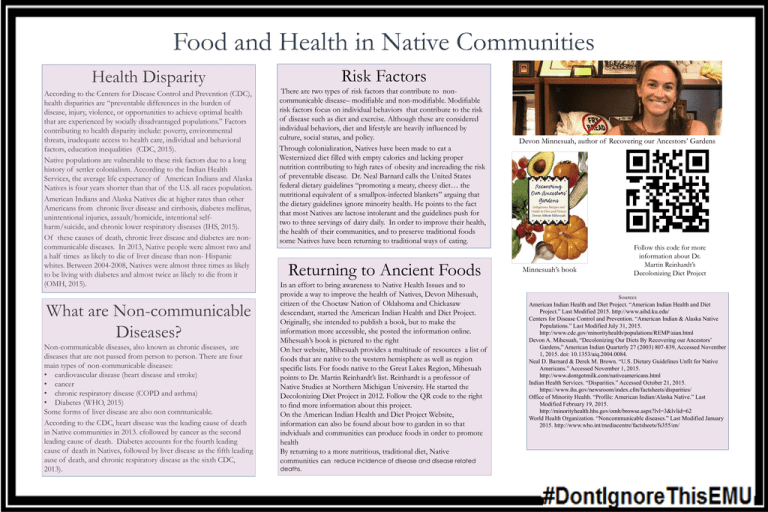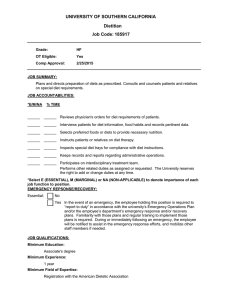Food and Health in Native Communities Health Disparity Risk Factors
advertisement

Food and Health in Native Communities Health Disparity According to the Centers for Disease Control and Prevention (CDC), health disparities are “preventable differences in the burden of disease, injury, violence, or opportunities to achieve optimal health that are experienced by socially disadvantaged populations.” Factors contributing to health disparity include: poverty, environmental threats, inadequate access to health care, individual and behavioral factors, education inequalities (CDC, 2015). Native populations are vulnerable to these risk factors due to a long history of settler colonialism. According to the Indian Health Services, the average life expectancy of American Indians and Alaska Natives is four years shorter than that of the U.S. all races population. American Indians and Alaska Natives die at higher rates than other Americans from chronic liver disease and cirrhosis, diabetes mellitus, unintentional injuries, assault/homicide, intentional selfharm/suicide, and chronic lower respiratory diseases (IHS, 2015). Of these causes of death, chronic liver disease and diabetes are noncommunicable diseases. In 2013, Native people were almost two and a half times as likely to die of liver disease than non- Hispanic whites. Between 2004-2008, Natives were almost three times as likely to be living with diabetes and almost twice as likely to die from it (OMH, 2015). What are Non-communicable Diseases? Non-communicable diseases, also known as chronic diseases, are diseases that are not passed from person to person. There are four main types of non-communicable diseases: • cardiovascular disease (heart disease and stroke) • cancer • chronic respiratory disease (COPD and asthma) • Diabetes (WHO, 2015) Some forms of liver disease are also non communicable. According to the CDC, heart disease was the leading cause of death in Native communities in 2013. cfollowed by cancer as the second leading cause of death. Diabetes accounts for the fourth leading cause of death in Natives, followed by liver disease as the fifth leading ause of death, and chronic respiratory disease as the sixth CDC, 2013). Risk Factors There are two types of risk factors that contribute to noncommunicable disease– modifiable and non-modifiable. Modifiable risk factors focus on individual behaviors that contribute to the risk of disease such as diet and exercise. Although these are considered individual behaviors, diet and lifestyle are heavily influenced by culture, social status, and policy. Through colonialization, Natives have been made to eat a Westernized diet filled with empty calories and lacking proper nutrition contributing to high rates of obesity and increading the risk of preventable disease. Dr. Neal Barnard calls the United States federal dietary guidelines “promoting a meaty, cheesy diet… the nutritional equivalent of a smallpox-infected blankets” arguing that the dietary guidelines ignore minority health. He points to the fact that most Natives are lactose intolerant and the guidelines push for two to three servings of dairy daily. In order to improve their health, the health of their communities, and to preserve traditional foods some Natives have been returning to traditional ways of eating. Returning to Ancient Foods In an effort to bring awareness to Native Health Issues and to provide a way to improve the health of Natives, Devon Mihesuah, citizen of the Choctaw Nation of Oklahoma and Chickasaw descendant, started the American Indian Health and Diet Project. Originally, she intended to publish a book, but to make the information more accessible, she posted the information online. Mihesuah’s book is pictured to the right On her website, Mihesuah provides a multitude of resources a list of foods that are native to the western hemisphere as well as region specific lists. For foods native to the Great Lakes Region, Mihesuah points to Dr. Martin Reinhardt’s list. Reinhardt is a professor of Native Studies at Northern Michigan University. He started the Decolonizing Diet Project in 2012. Follow the QR code to the right to find more information about this project. On the American Indian Health and Diet Project Website, information can also be found about how to garden in so that indviduals and communities can produce foods in order to promote health By returning to a more nutritious, traditional diet, Native communities can reduce incidence of disease and disease related deaths. Devon Minnesuah, author of Recovering our Ancestors’ Gardens Minnesuah’s book Follow this code for more information about Dr. Martin Reinhardt’s Decolonizing Diet Project Sources American Indian Health and Diet Project. “American Indian Health and Diet Project.” Last Modified 2015. http://www.aihd.ku.edu/ Centers for Disease Control and Prevention. “American Indian & Alaska Native Populations.” Last Modified July 31, 2015. http://www.cdc.gov/minorityhealth/populations/REMP/aian.html Devon A. Mihesuah, “Decolonizing Our Diets By Recovering our Ancestors’ Gardens,” American Indian Quarterly 27 (2003) 807-839, Accessed November 1, 2015. doi: 10.1353/aiq.2004.0084. Neal D. Barnard & Derek M. Brown. “U.S. Dietary Guidelines Unfit for Native Americans.” Accessed November 1, 2015. http://www.dontgotmilk.com/nativeamericans.html Indian Health Services. “Disparities.” Accessed October 21, 2015. https://www.ihs.gov/newsroom/index.cfm/factsheets/disparities/ Office of Minority Health. “Profile: American Indian/Alaska Native.” Last Modified February 19, 2015. http://minorityhealth.hhs.gov/omh/browse.aspx?lvl=3&lvlid=62 World Health Organization. “Noncommunicable diseases.” Last Modified January 2015. http://www.who.int/mediacentre/factsheets/fs355/en/


